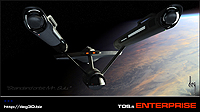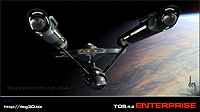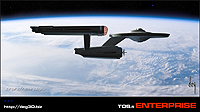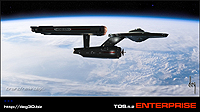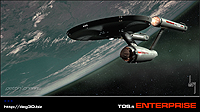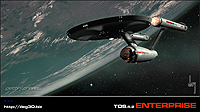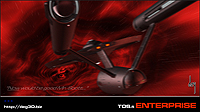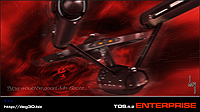-
Welcome! The TrekBBS is the number one place to chat about Star Trek with like-minded fans.
If you are not already a member then please register an account and join in the discussion!
You are using an out of date browser. It may not display this or other websites correctly.
You should upgrade or use an alternative browser.
You should upgrade or use an alternative browser.
What's this...? TOS.5.2
- Thread starter deg3D
- Start date
Lots and lots of improvements there, awesome work.
What Santaman said

Did you use a different lens between those two shots? Because I keep switching back and forth to compare the two versions and the warp nacellles seem MUCH longer on the 5.2 model (which is looking great BTW).
Thanks, guys! 
Ah, sure sure, have a good time, dude!
Thanks, and thanks for understanding, my friend.
Scott, .5 were all rendered in modo 302. .5.2 are all now rendered in LightWave 9.6. Even with the same lens settings, the cameras tend to behave a tad differently. Plus, while I had the .5 versions up for viewing reference while positioning the camera in LightWave, I did not hit a clone as far as positioning, as again, even though I plugged in the exact same position and rotation coordinates for the camera that I had in modo, it's never comes out exactly the same between the two programs, and thus I had to do some by-eye adjustments, eh.
Thanks, Prof!
deg

my wife's selling her art at the celtic fest in grant park this weekend.
visiting mitsuwa is just frosting.
Ah, sure sure, have a good time, dude!

Awesome, as always.Too bad about the release, but I totally understand. Some things are so good, you have to keep them to yourself.

Thanks, and thanks for understanding, my friend.

Did you use a different lens between those two shots? Because I keep switching back and forth to compare the two versions and the warp nacellles seem MUCH longer on the 5.2 model (which is looking great BTW).
Scott, .5 were all rendered in modo 302. .5.2 are all now rendered in LightWave 9.6. Even with the same lens settings, the cameras tend to behave a tad differently. Plus, while I had the .5 versions up for viewing reference while positioning the camera in LightWave, I did not hit a clone as far as positioning, as again, even though I plugged in the exact same position and rotation coordinates for the camera that I had in modo, it's never comes out exactly the same between the two programs, and thus I had to do some by-eye adjustments, eh.
Thanks, Prof!

deg
Ahh, that's right; I'd forgotten that you were rendering iteration 5.2 in LightWave (mebbe you should have called it the deg 9.6  ).
).
Modo certainly seems to have a pretty good render engine but the LightWave version looks like a film was lifted from in front of the lens... or do you think that's just the new and improved textures you're introducing in this release?
 ).
).Modo certainly seems to have a pretty good render engine but the LightWave version looks like a film was lifted from in front of the lens... or do you think that's just the new and improved textures you're introducing in this release?
Or is the difference the lighting? I'm really noticing how the Enterprise "comes alive" in the LightWave renders and how little details like the dome above the hangar deck and the spill from the stardrive's portholes is tons better than the Modo versions...
It's all the new lighting, Prof, that with the flares, plus the glow option for lum surfaces. The main surface textures are all the same maps. While modo has a great render engine, and is awesome for certain types of 3D (mainly product work, and stylized cartoon type stuff, IMO), it has none of the bells-and-whistles that LightWave has in regard to this type of work (space-ships).
I have wanted to create a modo-to-Lightwave pipeline for quite some time for this express reason, but got lazy and comfortable just staying in modo for everything. I could no longer take my vision of what I really wanted to see fall by the way-side though, so I knew it would be work, but I had to convert my E. And I'm sO glad I finally did.
Now I have a standard modo-to-Lightwave workflow for anything new and it's really no problem. It's the conversions of stuff finished in modo that takes time, having to redo everything.
deg's modeling and painting pipeline:
Model everything in modo. UV everything in modo. Name surfaces in modo. Apply basic surfacing attributes in modo. Bake AO maps in modo. Create alpha hold-out masks as needed in modo for painting in Photoshop. Paint maps in Photoshop. Apply maps (UV and/or some projection) in modo. Get everything finished up tight, and save out file as a LightWave file (modo has this option).
Create all pivot point positions in LightWave Modeler. Surface and tweak UV and/or projection map settings in LightWave Layout. Build light-rig(s) in LightWave Layout. Light scene(s) in LightWave Layout. Set up animations, local ship parts and/or overall scene, in LightWave Layout. Render in LightWave Layout.
deg
I have wanted to create a modo-to-Lightwave pipeline for quite some time for this express reason, but got lazy and comfortable just staying in modo for everything. I could no longer take my vision of what I really wanted to see fall by the way-side though, so I knew it would be work, but I had to convert my E. And I'm sO glad I finally did.
Now I have a standard modo-to-Lightwave workflow for anything new and it's really no problem. It's the conversions of stuff finished in modo that takes time, having to redo everything.
deg's modeling and painting pipeline:
Model everything in modo. UV everything in modo. Name surfaces in modo. Apply basic surfacing attributes in modo. Bake AO maps in modo. Create alpha hold-out masks as needed in modo for painting in Photoshop. Paint maps in Photoshop. Apply maps (UV and/or some projection) in modo. Get everything finished up tight, and save out file as a LightWave file (modo has this option).
Create all pivot point positions in LightWave Modeler. Surface and tweak UV and/or projection map settings in LightWave Layout. Build light-rig(s) in LightWave Layout. Light scene(s) in LightWave Layout. Set up animations, local ship parts and/or overall scene, in LightWave Layout. Render in LightWave Layout.
deg
OH, plus I had to use radosity to get any kind of glow off lum surfaces in modo, and esp. had to use it to achieve the .5 domes effect, as it depended on SSS and radiosity to get any kind of translucent look to it, and that SHOT the render times through the roof, up past an hour and 20 min, for 1280 x 720, if I got anywhere close to the domes.
Now in LightWave, I have a better overall dome(s) effect (IMO), and it renders in 20 odd min., at twice the size no less. All good, eh.
deg
Now in LightWave, I have a better overall dome(s) effect (IMO), and it renders in 20 odd min., at twice the size no less. All good, eh.

deg
I'm curious... why, then, do the modeling in Modo? Not that I have any issues with Modo (I've never even seen it running, bluntly stated.) But I know lots of people find it very easy working in Lightwave, and it just seems to me that working all in one tool probably has some serious advantages.OH, plus I had to use radosity to get any kind of glow off lum surfaces in modo, and esp. had to use it to achieve the .5 domes effect, as it depended on SSS and radiosity to get any kind of translucent look to it, and that SHOT the render times through the roof, up past an hour and 20 min, for 1280 x 720, if I got anywhere close to the domes.
Now in LightWave, I have a better overall dome(s) effect (IMO), and it renders in 20 odd min., at twice the size no less. All good, eh.
deg
Granted, I'm working in multiple tools, but that's because I do my modeling in CAD (which is massively computationally intensive) then export to surface-based formats for rendering (which loses much of the fine geometrical accuracy but uses tremendously less system resources, allowing for some much more snappy rendering times). In other words, my main goal is to create the massive, mathematically-perfect model. If I want to render it, I export it to whatever level of detail I need it to be in, in order to render. My "separation of tools," although inconvenient in some ways, is really a necessity right now, not something I'd choose if the option was there to do really high-end renders directly from my modeling tool.
Everything I know about Lightwave is that it's got an excellent modeling toolkit as well as a nice rendering toolkit. I've used it a bit (several revs back) and ended up choosing Maya as my tool of choice, but that's because I love the "everything can drive everything else" aspect of Maya, not necessarily some of the tool implementations (which, I think, Lightwave held an advantage in... at least it did at the time!)
So... other than "familiarity," is there some driving factor behind splitting the work between multiple tools in your case?
Not that I'm complaining, I'm just really curious. If you have a great reason, I'm always looking to learn!

^modo (lowercase "m," by the way, even when starting sentences) knocks the socks off of LightWave, modeling-wise. I've not used it much, but a coworker at my prior job used his personal license at the office, and it is some awesome shit. Probably the best modeling package out there from what I saw, as Luxology was founded by former Lightwave programmers who weren't satisfied with how NewTek was handling the development of LightWave; they took their design documents with them, and essentially turned modo into what they wanted LightWave to be.
Or, to put it another way, modo is LightWave with the awesome turned up to 11 and cross-pollinated with the best modeling tool used in other packages like 3D Studio Max.
Cross-program workflow isn't an issue, either; when said coworker and I were working on a personal project together, he modeled in modo, I modeled in LightWave and we rendered in Maya. The integration was pretty seamless; modo has a ton of presets for exporting to native file formats, and it works pretty well.
Or, to put it another way, modo is LightWave with the awesome turned up to 11 and cross-pollinated with the best modeling tool used in other packages like 3D Studio Max.
Cross-program workflow isn't an issue, either; when said coworker and I were working on a personal project together, he modeled in modo, I modeled in LightWave and we rendered in Maya. The integration was pretty seamless; modo has a ton of presets for exporting to native file formats, and it works pretty well.
How much is modo?
And on the model, can you post some of the more shots of the ship, like firing phasers, Planet orbit, warp, coming out of warp, and a shuttle entering the shuttlebay? This is an awesome model, and I'd love to see it recreating (in a way) some of the scenes from TOS. If this were the model on TOS-R, that would've been amazing...
And on the model, can you post some of the more shots of the ship, like firing phasers, Planet orbit, warp, coming out of warp, and a shuttle entering the shuttlebay? This is an awesome model, and I'd love to see it recreating (in a way) some of the scenes from TOS. If this were the model on TOS-R, that would've been amazing...
^modo (lowercase "m," by the way, even when starting sentences) knocks the socks off of LightWave, modeling-wise. I've not used it much, but a coworker at my prior job used his personal license at the office, and it is some awesome shit. Probably the best modeling package out there from what I saw, as Luxology was founded by former Lightwave programmers who weren't satisfied with how NewTek was handling the development of LightWave; they took their design documents with them, and essentially turned modo into what they wanted LightWave to be.
Or, to put it another way, modo is LightWave with the awesome turned up to 11 and cross-pollinated with the best modeling tool used in other packages like 3D Studio Max.
Cross-program workflow isn't an issue, either; when said coworker and I were working on a personal project together, he modeled in modo, I modeled in LightWave and we rendered in Maya. The integration was pretty seamless; modo has a ton of presets for exporting to native file formats, and it works pretty well.
That's sorta the Luxology story, kinda, as I believe there was some creative and/or compensatory tension inside the company, sure. But I feel it was more the classic American success story of, Hey, we're the brains behind making the product here (Allen and Stuart), and the market savvy promotion (Brad and Bob), it's time we struck out on our own and start working for ourselves, and being our own bosses type of thing. Still, this is just stuff I've picked up. Only the Lux guys (Allen, Stuart, Brad, and Bob and the others) know the real answer. Either way, I'm glad the struck out on their own, eh.
How much is modo?
And on the model, can you post some of the more shots of the ship, like firing phasers, Planet orbit, warp, coming out of warp, and a shuttle entering the shuttlebay? This is an awesome model, and I'd love to see it recreating (in a way) some of the scenes from TOS. If this were the model on TOS-R, that would've been amazing...
Can't recall the price off hand, JJohnson, as I have just paid upgrade prices for years now. Check the Lux website, eh. And I will be creating all sorts of new artwork with .5.2 as well as first updating the old .5 versions to .5.2. Gimme some time, eh. I'll post 'em as they are done.

Now, as to why I use modo, Cary...
modo is, most simply put, how modeling should be, IMO. It's not a matter of being familiar and/or comfortable in it, as I am, or at least was, quite adept in LightWave Modeler. I built my Slave 1 in Modeler and it is an infinitely more complicated mesh to build than E.
The reason I picked up modo originally was, I was on Jose A. Perez's website and saw he used it. And, as my part of success philosophy is, pick someone who is already successful doing what it is you yourself want to be successful doing and emulate them, I said, well, if Jose is using modo, there must be something to it, and if it's good enough for him, it'll most likely me good enough for me.
And it was. I picked up a copy off eBay (a legal and fully authorized transfered copy of course, that a digi photographer won as a door-prize at a photographer's conference in LA, but he had no use for it), and 20 min. after opening modo I said, Oh yeah, this is how modeling should be, eh.
Bottom-line, it's so intelligent and intuitive. Like any "new" program, it takes getting used to. But Lux's help system with its comprehensive array of tut vids is unsurpassed in getting one up to speed. For the sake of time and further questions, if you want to know more, best thing would be to drive the demo, eh.
Now, modo has a great rendering engine, and I got way too comfortable just staying in modo for everything. But my art was suffering for it. modo far surpasses Modeler in the modeling dept., and Modeler cannot even come CLOSE to modo's ability to UV, but as far as rendering bells-and-whistles and lighting, and creating light-rigs for space type stuff like I do, LightWave Layout in still the champ, and far as post filters and lighting options, etc.
So I knew I had to, and knew it would be a lot of work, but I had to port my E to LightWave to get her to the level I always wanted her to be, and knew I could do that with Layout. I had to break the comfortable habit of staying all in modo that I had formed or fallen into. I had to go back and polish up and improve my LightWave Layout skillz that had been left by the way-side for 3 or so years.
In pro work, nothing is, or is rarely ever done all in one program these days. That's the exception if ever done. Multi-program pipelines are the norm these days, and it's getting better and better as the file formats are getting to a point of being far more transferable and compatible going cross-program. SOPs have to be set up to do so as cleanly as possible of course, but that is becoming the norm to set up. Just takes the up-front time to do right, eh.
deg
Thanks for the information on the workflow deg. You've just convinced me NOT to purchase modo... at least not until the first point release for LightWave Core is released, and then I can decide whether to stick with one system (which you have to admit is much simpler from a workflow standpoint) or give modo serious consideration. (Besides, this damn Doomsday Machine project takes up so much of my free time that I don't have time for new modeling right now anyway!)
modo is, most simply put, how modeling should be, IMO.
I have no experience with any 3D package other then modo and Lightwave, the first of which is much, much more intuitive (even though it still has some interface related issues and a few crashes due to bugs here and there).
I was planning on trying other modeling packages, hoping they're even better to use then modo, but now I'm afraid to, fearing it to be a waste of time, seeing as I'm mostly interested in the modeling part.

Last edited:
Thanks for the information on the workflow deg. You've just convinced me NOT to purchase modo... at least not until the first point release for LightWave Core is released, and then I can decide whether to stick with one system (which you have to admit is much simpler from a workflow standpoint) or give modo serious consideration. (Besides, this damn Doomsday Machine project takes up so much of my free time that I don't have time for new modeling right now anyway!)
Naaa, for myself anywho, like anything, once you have a workflow established, it's no more a problem really than going between Modeler and Layout, and the advantages modo brings to modeling and UV'ing far outweigh anything the Hub could ever provide convenience-wise, IMO, eh.
modo is, most simply put, how modeling should be, IMO.
I have no experience with any 3D package other then modo and Lightwave, the first of which is much, much more intuitive (even though it still has some interface related issues and a few crashes due to bugs here and there).
I was planning on trying other modeling packages, hoping they're even better to use then modo, but now I'm afraid to, fearing it to be a waste of time, seeing as I'm mostly interested in the modeling part.
I very very very very rarely have programs, 3D or otherwise, crash. Like any program, I have run into a coupla snigglets in modo that I've noted now and avoid that will crash her, but overall, no prob.
As far as the GUI, it 100% malleable/customizable, thus anything I don't care for, I change to my liking.
deg
OOOOH, pretty!!! 

(One small note: Are you "frosting" the translucency of the lower sensor dome on the primary hull and/or using a volumetric light for that large glowing object? If so, you might want to check your translucency and/or volumetric density settings, b/c I can see the outline of the other side of the dome on the "5.2" pic. Yeah, I'm that anal )
)
Edited to add: Here's what I'm referring to:



(One small note: Are you "frosting" the translucency of the lower sensor dome on the primary hull and/or using a volumetric light for that large glowing object? If so, you might want to check your translucency and/or volumetric density settings, b/c I can see the outline of the other side of the dome on the "5.2" pic. Yeah, I'm that anal
 )
)Edited to add: Here's what I'm referring to:

Okay... the "wormhole" shot, I can't find any thing to comment on. Light, within a wormhole, is entirely subjective, since we don't know what a wormhole really looks like.
But... I'm "unconvinced" by the orbital shots. The reason is that the light source required to get that appearance for a planetary surface isn't the same as required to get that appearance for the ship.
In the first image, the sun would be "high, above your left shoulder" to get that lighting on the planet, I think. But the light for the ship seems to be coming from an entirely different direction. Also, I'm not really seeing "bounce" from the planetary surface.
Similarly, for the second "orbit" shot, to get that sort of lighting on the planet, the sun would be low and to the right... in front of you and well downwards. That means that the underside of the primary hull should be brilliantly illuminated, not "in shadow."
That's how it strikes me. Incompatible lighting for different elements of a shot is one of the first things that makes me react "ITS A FAAAAAKE!"
Do you guys (and Deg in particular, of course) see what I'm getting at? Do you agree? Disagree?
Similar threads
- Replies
- 53
- Views
- 9K
- Replies
- 16
- Views
- 417
If you are not already a member then please register an account and join in the discussion!


